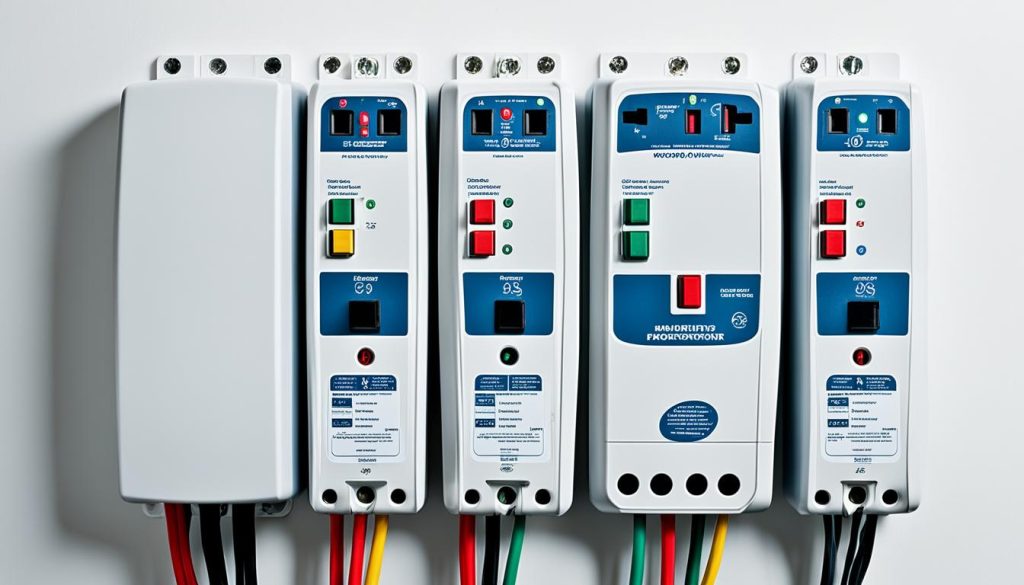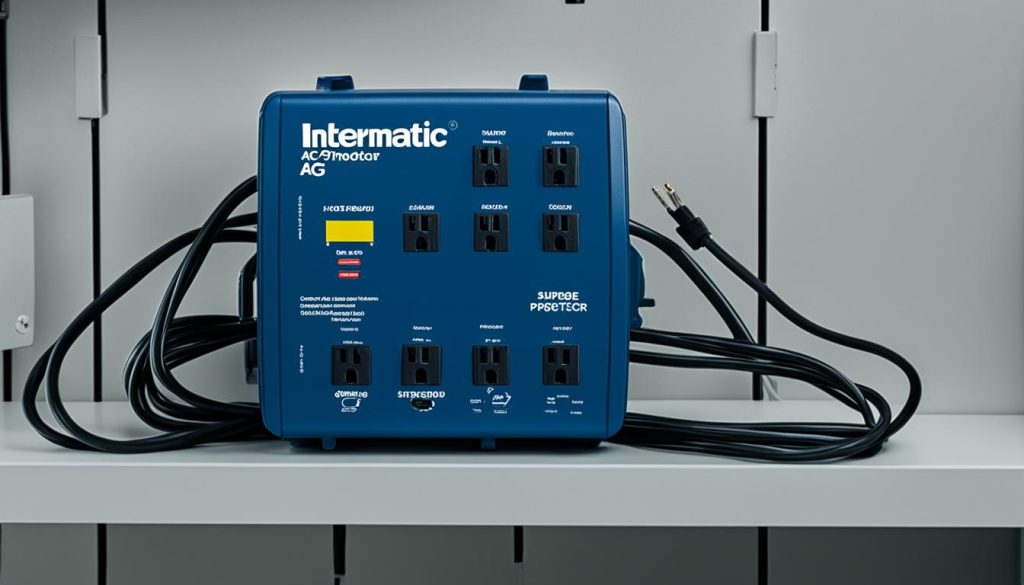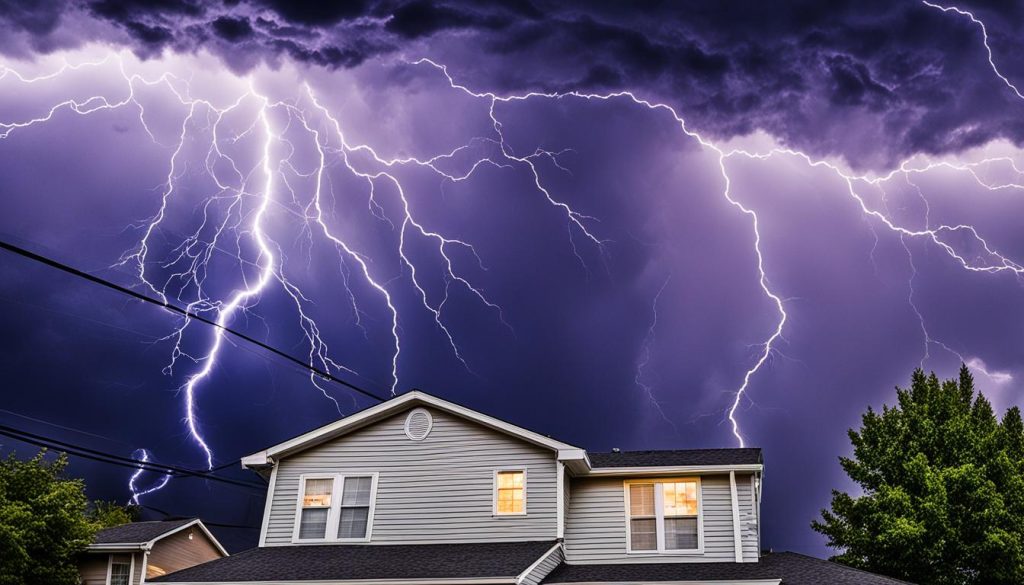Your air conditioner is a crucial appliance for keeping your home cool and comfortable. However, it is vulnerable to power surges, which can cause significant damage to its electronic components. By plugging your AC into a surge protector, you can protect it from potential voltage spikes, ensuring its longevity and optimal performance.
Key Takeaways:
- Power surges can damage your AC’s electronic components and lead to costly repairs or system failure.
- Surge protectors divert excess voltage to the ground, preventing it from reaching your AC.
- There are two main types of surge protectors for AC: whole-house and dedicated AC surge protectors.
- Factors to consider when choosing a surge protector include Joule rating, UL 1449 certification, warranty, and surge protector installation.
- The Intermatic AG3000 surge protector is a recommended option for protecting your AC.
Understanding Power Surges and Their Impact on Your AC
Power surges are sudden, brief spikes in voltage that can occur in your electrical system. They can be caused by various factors, such as lightning strikes, faulty wiring, power grid fluctuations, or the turning on and off of large appliances. These surges carry thousands of volts and can have a detrimental effect on your air conditioning (AC) unit.
The sensitive electronic components of your AC, including compressors, capacitors, thermostats, and control boards, are particularly vulnerable to the damage caused by power surges. These voltage spikes can lead to reduced efficiency, loss of cooling capacity, and even complete system failure.
When a power surge occurs, the excess voltage can overwhelm the delicate circuitry inside your AC, causing irreversible damage. This damage is often costly to repair and may require replacing entire components or even the entire AC unit itself.
To put it simply, power surges pose a significant threat to the proper functioning and longevity of your AC. Investing in surge protection is crucial to safeguard your AC from potential damage and ensure its continued performance.
Power surges can carry thousands of volts and damage the sensitive electronic components of your AC, such as compressors, capacitors, thermostats, and control boards.
By understanding how power surges affect your AC, you can take proactive steps to protect your investment and prevent unnecessary expenses.
Damage Caused by Power Surges to Your AC
When power surges occur, they can lead to various types of damage to your AC, including:
- Shortened lifespan: Power surges can significantly shorten the lifespan of your AC unit. The stress and damage caused by voltage spikes can lead to premature failure and the need for costly repairs or replacements.
- Reduced efficiency: Power surges can affect the performance and efficiency of your AC, leading to increased energy consumption and higher utility bills.
- Loss of cooling capacity: The damage caused by power surges can result in a reduced cooling capacity, leaving you with an AC that struggles to maintain a comfortable indoor temperature.
- Complete system failure: In severe cases, power surges can cause complete system failure, rendering your AC inoperable and requiring a complete replacement.
Protecting your AC from power surges is essential to avoid these potential issues and ensure the optimal performance and longevity of your cooling system.
How Surge Protectors Work
Surge protectors are essential devices that safeguard your electronic equipment, including your AC, from the damaging effects of power surges. But how exactly do surge protectors work?
Surge protectors utilize various components to detect and divert excess voltage away from your AC. One of the key components used in surge protectors is Metal Oxide Varistors (MOVs). These MOVs are designed to react to sudden voltage spikes by becoming conductive and diverting the excess voltage to the ground.
Additionally, surge protectors may include features such as thermal fuses, indicators, and noise filtering capabilities. Thermal fuses act as a safety mechanism and cut off power to the surge protector if it overheats due to a surge. Indicators inform you if the surge protector is functioning properly or if it needs to be replaced. Noise filtering capabilities reduce electromagnetic interference and improve the overall performance of your AC.
“Surge protectors use a combination of components to detect and divert excess voltage, protecting your AC from potential damage.” – Electrical Engineer, Jane Thompson
The surge protector works as a line of defense between the power source and your AC, ensuring that any voltage surges are controlled and prevented from reaching your valuable electronic equipment.

Components of Surge Protectors
Surge protectors consist of several key components that work together to provide reliable protection for your AC:
| Component | Function |
|---|---|
| Metal Oxide Varistors (MOVs) | React to voltage spikes and divert excess voltage to the ground. |
| Thermal Fuses | Act as a safety mechanism and cut off power if the surge protector overheats. |
| Indicators | Show the status of the surge protector, indicating if it is functioning properly. |
| Noise Filtering Capacitors | Reduce electromagnetic interference and enhance the performance of your AC. |
Understanding how surge protectors work and the components they utilize can help you make an informed decision when selecting the right surge protector to safeguard your AC from power surges.
Types of Surge Protectors for AC
When it comes to protecting your AC unit from power surges, there are two main types of surge protectors to consider: whole-house surge protectors and dedicated AC surge protectors.
Whole-house surge protectors are installed at the main electrical panel of your home. They provide comprehensive protection for all electrical devices, including your AC. By safeguarding the entire electrical system, whole-house surge protectors ensure that every appliance is shielded from voltage spikes.
Dedicated AC surge protectors are specifically designed for air conditioners. These surge protectors are installed directly at the AC unit, providing targeted protection. By focusing on the AC system, dedicated surge protectors offer enhanced defense against power surges that could potentially damage vital components of your AC.
When choosing between whole-house surge protectors and dedicated AC surge protectors, it’s important to consider your specific needs and preferences. Whole-house surge protectors offer comprehensive protection for your entire home, while dedicated AC surge protectors provide targeted defense specifically for your air conditioning system.
Take into account factors such as your home’s electrical system, budget, and the importance of protecting individual appliances. For optimal protection, consulting with a professional electrician can help you make an informed decision and ensure proper installation.
Comparison of Whole-House and Dedicated AC Surge Protectors
| Aspect | Whole-House Surge Protectors | Dedicated AC Surge Protectors |
|---|---|---|
| Installation | At the main electrical panel | Directly at the AC unit |
| Scope of Protection | All electrical devices in the home | Specifically designed for air conditioners |
| Targeted Defense | No | Yes |
| Customizable | No | No |

Factors to Consider When Choosing a Surge Protector for AC
When selecting a surge protector for your AC, there are several important factors to consider:
- Joule rating: The Joule rating indicates the capacity of a surge protector to absorb energy from power surges. A higher Joule rating means the surge protector can handle larger surges and provide better protection for your AC.
- UL 1449 certification: Look for a surge protector that is UL 1449 certified. This certification ensures that the surge protector meets safety and performance standards set by Underwriters Laboratories.
- Warranty and connected equipment coverage: Check the warranty offered by the surge protector manufacturer. A longer warranty period provides peace of mind and indicates confidence in the product’s quality. Additionally, consider the connected equipment coverage, which offers financial protection in the event that your AC or other connected devices are damaged by a power surge.
- Type of surge protector: Decide whether you need a whole-house surge protector or a dedicated AC surge protector. Whole-house surge protectors provide protection for all electrical devices in your home, including your AC, while dedicated AC surge protectors are specifically designed for air conditioners.
- Response time: The response time of a surge protector refers to how quickly it can react to a power surge. Look for a surge protector with a fast response time to ensure that it can effectively protect your AC.
- Surge protector installation: Consider whether professional installation is recommended or required for the surge protector you choose. Professional installation can ensure optimal protection and proper wiring.
By considering these factors, you can choose the right surge protector for your AC and help protect it from damaging power surges.
The Intermatic AG3000 Surge Protector – Best Option for AC
To ensure optimal protection for your AC unit from power surges, the Intermatic AG3000 surge protector is the best option available in the market. Specifically designed for HVAC systems and other large appliances, the AG3000 offers advanced features and robust performance.
Key Features of the Intermatic AG3000 Surge Protector
The Intermatic AG3000 surge protector comes with a range of features that make it the ideal choice for safeguarding your AC unit:
- NEMA 3R-rated enclosure for outdoor use: The AG3000 is designed to withstand harsh weather conditions, ensuring reliable protection for your AC unit, even in outdoor installations.
- Type 2 SPD for lightning strike protection: Equipped with a Type 2 Surge Protective Device (SPD), the AG3000 provides effective defense against power surges caused by lightning strikes, offering peace of mind during stormy weather.
- Green LED indicator for proper functioning: The AG3000 surge protector features a green LED indicator that allows you to easily check its status, ensuring that it is functioning correctly and providing continuous protection for your AC unit.
- 120/240V single-phase protection: With its 120/240V single-phase protection capability, the AG3000 is designed to handle the voltage requirements of your AC unit, ensuring comprehensive surge protection.
- 3-year limited warranty: The Intermatic AG3000 comes with a generous 3-year limited warranty, demonstrating the manufacturer’s confidence in the durability and reliability of their product.
With its exceptional build quality, advanced features, and comprehensive protection capabilities, the Intermatic AG3000 surge protector is the top choice for safeguarding your AC unit against power surges.

Please make sure to place the image in the center of the section.
| Features | Description |
|---|---|
| NEMA 3R-rated enclosure | Designed for outdoor use |
| Type 2 SPD | Provides protection against lightning strikes |
| Green LED indicator | Allows easy status monitoring |
| 120/240V single-phase protection | Handles voltage requirements of AC units |
| 3-year limited warranty | Offers additional peace of mind |
Why an AC Needs a Surge Protector
When it comes to protecting your air conditioning (AC) unit, a surge protector is an essential investment. AC units are vulnerable to power surges due to their electronic components and the high electricity draw during startup. Without proper protection, power surges can cause significant damage to your AC, leading to costly repairs or even the need for a complete replacement.
A power surge can wreak havoc on essential components such as motors, circuit boards, and compressors, rendering your AC unit ineffective. The cost of repairing or replacing these parts can quickly add up, putting a strain on your budget. By using a surge protector specifically designed for AC units, you can prevent damage and avoid these unnecessary expenses.
Not only does a surge protector protect your AC from damage, but it also plays a crucial role in maintaining your warranty coverage. Most AC manufacturers require proper surge protection as a condition for warranty protection. Failing to use a surge protector can void your warranty, leaving you responsible for any repairs or replacements that may be needed.
Investing in a surge protector offers long-term cost savings. By safeguarding your AC unit from power surges, you can prolong its lifespan and avoid the need to spend money on repairs or a new system. Additionally, a surge protector provides peace of mind, knowing that your investment is protected against unexpected voltage spikes.
Don’t let power surges put your AC unit at risk. Invest in a surge protector and enjoy the benefits of protecting your warranty, ensuring cost savings, and maintaining a cool and comfortable home.

| Benefits of Using a Surge Protector for Your AC | Importance |
|---|---|
| Protection against power surges | Prevent damage to your AC’s electronic components |
| Maintain warranty coverage | Keep your warranty intact by complying with manufacturer requirements |
| Cost savings | Avoid expensive repairs or replacements |
| Extended lifespan of your AC unit | Protect your investment and avoid AC failure |
The Importance of Surge Protection for Electronics
When it comes to protecting your electronic devices, surge protection is absolutely essential. Power surges can occur at any time and pose a serious threat to your computers, televisions, home theater systems, and other appliances. These voltage spikes can cause extensive damage, leading to data loss, functionality issues, and expensive repairs.
Investing in surge protectors is a smart choice to safeguard your valuable electronics. These devices provide an extra layer of protection by diverting excess voltage away from your devices, preventing damage from power surges. Surge protectors act as a barrier, ensuring that only clean and stable power reaches your electronics, enhancing their longevity and overall performance.
By utilizing surge protectors for all your electronic devices, you can minimize the risk of damage from unexpected power surges. It’s important to choose surge protectors that are appropriate for the specific needs of your devices. Look for surge protectors with sufficient Joule ratings, as well as those that are UL certified to ensure they meet safety and performance standards.
FAQ
Why should I plug my AC into a surge protector?
Plugging your AC into a surge protector helps protect it from potential damage caused by power surges. Power surges can lead to costly repairs or even complete system failure of your AC.
What causes power surges?
Power surges can be caused by lightning strikes, faulty wiring, power grid fluctuations, or the turning on and off of large appliances.
How do surge protectors work?
Surge protectors work by diverting excess voltage to the ground, preventing it from reaching your AC. They use components like Metal Oxide Varistors (MOVs) to detect and react to increased voltage.
What are the types of surge protectors for AC?
There are two main types: whole-house surge protectors and dedicated AC surge protectors. Whole-house surge protectors are installed at the main electrical panel and provide protection for all devices in your home, including your AC. Dedicated AC surge protectors are installed at the AC unit and provide targeted protection.
What factors should I consider when choosing a surge protector for AC?
Consider the Joule rating, which indicates the capacity to absorb energy from power surges, the UL 1449 certification for safety and performance standards, the warranty and connected equipment coverage, the type of surge protector, and the response time. Professional installation may also be recommended.
Which surge protector is recommended for AC units?
The Intermatic AG3000 surge protector is a recommended option for protecting your AC unit. It is specifically designed for HVAC systems and features a NEMA 3R-rated enclosure, Type 2 SPD for lightning strike protection, and a 3-year limited warranty.
Why is a surge protector important for an AC?
AC units are susceptible to power surges due to their electronic components and high electricity draw during startup. Using a surge protector helps prevent damaged motors, circuit boards, or compressors, and maintains warranty coverage.
Are surge protectors important for other electronic devices?
Yes, surge protection is essential for all electronic devices in your home. Power surges can damage computers, televisions, home theater systems, and other appliances. Surge protectors offer an extra layer of protection and minimize the risk of damage from voltage spikes.


